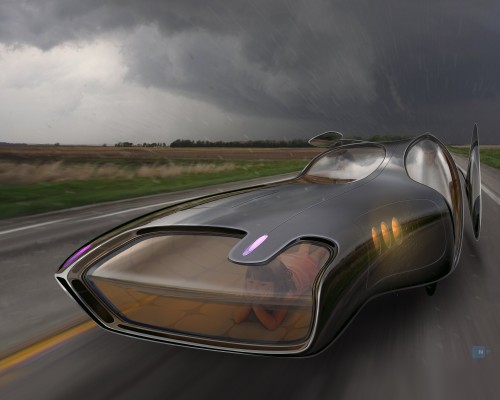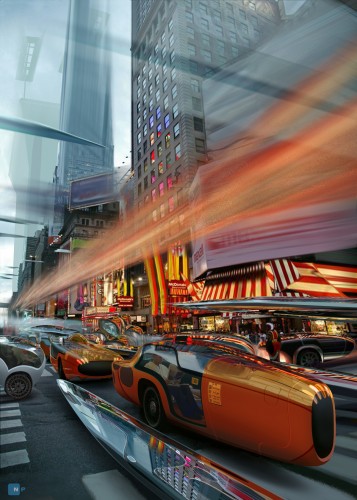Like Odo in Star Trek: Deep Space Nine, the Car of the Future is a shapeshifter. They say that ‘space is the final frontier’ and that is true on earth as well. Real estate is fundamentally limited by the surface area of the planet. More of it is not currently in production. As population continues to increase and our cities become ever more dense the need will arise to develop new technologies that actively compact and minimize the products we use, especially the automobile.
ROUTE 66 CIRCA 2100
© Copyright Nick Pugh, 2010
Driving in the rain is fun. The vehicle moves effortlessly at 250 mph on the open road with a family of three safely inside. At high speed the body shape elongates providing a front-end structure that will absorb energy in the event that it should need to pass closely around another vehicle or object. At these speeds the wheel shape is tall and narrow maximizing efficiency through minimized drag. Each wheel has its own motor and the fuel is stored in a porous hydride material that is sandwiched between two floor membranes. The active interior safety system is completely inert unless needed providing complete freedom of movement for the passengers during smooth periods of driving. As the vehicle performs turns, stops or needs to avoid a collision the cushioned inside surface rapidly conforms around the occupants bodies momentarily fixing their position avoiding injury or discomfort.
So much of our urban real estate is dedicated to cars that traffic and general congestion abound. Parked cars are especially wasteful of space as they take up just as much surface area when unoccupied as in use. TCOF will give rise to a new era where our machines compact themselves into conforming shapes during use and in storage. ‘Form follows function’ becomes ‘form follows action’ as the animated mechanisms in our lives continue to change shape and size depending on need. Safety systems and user comfort will increase in effectiveness as the animated technology will both free us of current static restraints and allow for an ‘active intelligent defense’ against other moving and stationary objects as we drive.
This may seem a far-fetched and impractical idea but developments currently under way are setting the stage for TCOF and its morphic qualities. The ancient art of origami gives us inspiration that surfaces can be folded up in artistic and mathematically perfect ways. The inventor Charles Hoberman has shown how geodesic structures can be mechanically folded into a wide range of proportions and shapes. Dr. David Huffman the great mathematician, pioneered ‘perfect surfaces’ combining ideal math formulas with origami to hint at the untapped potential of high density folding packages and contemporary artists like Polyscene have shown how these ideas can be applied to create fabulously beautiful surfaces out of plastic. The genetic engineer Paul Rothemund has applied origami principles to make major breakthroughs in folding DNA into purposeful shapes and stands on the cusp of winning the Feynman prize in self assembling nanotechnology. And of course advanced, flexible composite materials, high speed computing power and integrated micro mechanics of all types are well developed.
All of these pioneering efforts amongst many others have laid a strong foundational understanding of how we might create functional shape shifting devices with next generation technology.
TIMES SQUARE CIRCA 2100
© Copyright Nick Pugh, 2010
Yellow is still the color of taxicabs! Other than that, much has changed during the 21st century. Gyroscopic technology has allowed most vehicles to operate on one or two wheels. This increases efficiency and gives them a smaller overall footprint alleviating the still problematic concern of congestion. Shape changing materials are commonplace and they help maximize usable interior space by growing or shrinking depending on how many passengers are inside. Parked cars condense to the size of a large suitcase and self stack creating dense clusters and large expanses of open space. Driving has become optional with automated inter-vehicle communications and robotic artificial intelligence systems. Cars move at a rapid pace similar to a flock of birds where each individual is independent but all act as a coordinated whole. This, combined with flexible dynamic body skins, has all but eliminated damaging accidents; vehicles touch each other and pedestrians alike as the flow of cross traffic intersects without the need for stoplights.

